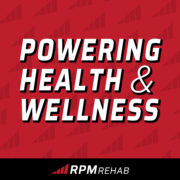Providing Elite Physical Care with Randy Bauer
RPM physical therapist Randy Bauer guides us through his holistic approach to recovering movement that he uses on everybody from Olympic athletes to Average Joes.
When Randy Bauer was in college, his focus was on football. That is until an injury on-the-field opened his eyes to the world of physical therapy. He began to work with collegiate athletes to help them preserve their personal health assets.
“It was being involved with the athlete in the day to day. It wasn’t just seeing them at a game, it was dealing with their practices, being out on the playing field and really seeing how these different athletes practiced,” he said.
Bauer has now been working as a physical therapist for over thirty years and has provided care to a large number of elite athletes, from track star Edwin Moses to tennis player Michael Chang.
In this episode of Powering Health and Wellness with RPM Rehab, Bauer breaks down what it takes to train elite athletes, the importance of building meaningful relationships with every client and how every facet of our lives can define our ability to move.
Adjusting to the world of athletes
Clients with a wide range of abilities often come into Bauer’s office at RPM Rehab. In his long career he has seen an extensive list of elite athletes, from the collegiate level all the way up to Olympic competitors.
For patients with such a skill level, he finds he has to adjust his therapeutic approach.
“They maintain their conditioning, and their training level is impeccable,” said Bauer. “You see a different level in the way people prepare themselves through a season, how they recover for off-season and how they prepare themselves for the upcoming season.”
In his experience, Bauer has noticed that these professional athletes are models in taking their personal health assets seriously. They always come prepared and ready to maximize their sessions.
“When your livelihood is dependent on it and your longevity in the sport is dependent upon it, you’re going to put that effort in.”
One reason athletes have so much success in their therapy sessions is because they have an acute awareness of what their body needs. One of the most important things any patient can do is listen to their body.
This intense focus on personal health and wellbeing is something anyone – whether an athlete or not – can bring into their lives.
“My emphasis is educating people inside the clinic and outside the clinic on how they can maximize their health and longevity around what they do.”
Maintaining meaningful relationships
In order to watch someone improve their overall health and well-being, you have to stick with your clients. One of the keys to success is building a meaningful relationship between therapist and patient.
“That’s something I’ve really enjoyed: the relationships that I have developed with not just the athletes that I see, but the various patients and the generations I might see in one family.”
Over the years, Bauer says he has seen the difference this kind of long-term investment in patients can make. He’s seen one patient for a little over thirty years.
“Over time, I’ve seen a few joints being replaced in that one person. And maybe a back surgery,” said Bauer. “And that develops a close tie with the individual and that extends to other clients that I have and that’s why I enjoy being in the community.”
These intimate relationships unlock whole new possibilities for therapist and patient. By getting to know a patient’s personal history, their comfort levels and their physical limitations, Bauer is able to work through these obstacles to reach new levels of growth.
But, what is most important is that this relationship allows him to bring out the best in his patients.
“That might be feeling relaxed in the setting that they’re in. It might be motivating them to do more when they’re not in the office to help their condition. And it’s follow up communication. That’s where I would say my success is: the development of relationships.”
A holistic approach to physical therapy
When approaching a new patient, it’s important to look at more than just what they bring into a session. Physical therapists need to take a holistic look at the people who come into their office.
“You need to know how they’re using their body day in and day out,” said Bauer. “You need to know what they’re doing to provide the adequate energy supply to work. Because that’s what you’re trying to do: step up their tolerance to work.”
This means considering things like what a patient’s diet looks like, how much sleep they get each night and the amount of relaxation built into their day. All of these things will play a role in their therapy sessions.
“There has to be a look at the total patient.”
To learn more about this show, follow this podcast wherever you listen to your audio content. And join in the conversation by visiting us online at rpmrehab.com/podcast.

